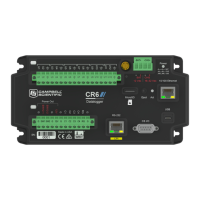8. Accept the default value of 00 seconds in the COM Port Communication Delay - this box is
used to allow time for hardware devices to "wake up" and negotiate a communications
link. Click Next.
9. In the previous instruction "Configuring a Connection to an RF407-Series Radio," you were
asked to select an active interface option of USB or RS-232. If you selected USBas the
active interface for the radio, you do not need to select a baud rate. If you selected RS-232,
set the baud rate to the one chosen during that step. The radio's default baud rate is
115200. The PakBus address must match the hardware settings for your data logger. The
default PakBus Address is 1.
10. Click Next.
11. By default, the data logger does not use a security code or a PakBus encryption key.
Therefore, the Security Code can be left at 0 and the PakBus Encryption Key can be left
blank. If either setting has been changed, enter the new code or key. See Data logger
security (p. 111) for more information.
12. Click Next.
13. Review the Communication Setup Summary. If you need to make changes, click the
Previous button to return to a previous window and change the settings.
Setup is now complete, and the EZSetup Wizard allows you to click Finish or click Next to test
communications, set the data logger clock, and send a program to the data logger. See Testing
communications with EZSetup (p. 41) for more information.
If you experience network communications problems, see Troubleshooting Radio
Communications (p. 134) for assistance.
3.1.5.3 RF407-Series radio communications with multiple data loggers
using one data logger as a router
This type of network configuration is useful for communicating around an obstacle, such as a hill
or building, or to reach longer distances.
To configure an RF407-series radio to communicate with multiple data loggers through a router,
you must complete the following steps (instruction follows):
3. Setting up the CR6 32

